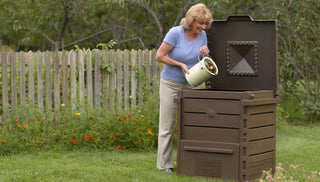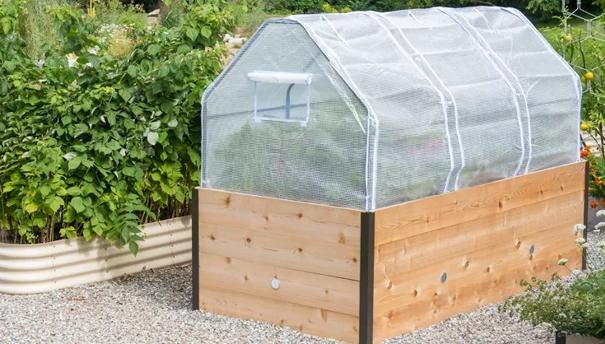Building and maintaining a compost pile is the surest, easiest way to become a better gardener. Not only will you be producing the best possible food for your garden, but by watching leaves, eggshells, orange rinds, and grass clippings become transformed into rich compost filled with earthworms and other soil creatures, you'll be learning what healthy soil is all about.
In This Article
 Compost is a rich and crumbly blend of partially decomposed organic material that does wonderful things for your garden.
Compost is a rich and crumbly blend of partially decomposed organic material that does wonderful things for your garden.Why Use Compost?
Compost improves soil structure.
Most gardeners don't start with great soil. Whether yours is hard and compacted, sandy, stony, heavy, or wet, adding compost will improve its texture, water-holding capacity, and fertility. Your soil will gradually become fluffy and brown—the ideal home for healthy plants.
Compost provides a balanced source of plant nutrients.
Even if you are lucky enough to have great soil, you can't expect that soil to remain rich and productive without replenishing the nutrients that are consumed each growing season. No commercial fertilizer, even one that is totally organic, provides the full spectrum of nutrients that you get with compost. The nutrients are available gradually, as your plants need them, over a period of months or years. The microorganisms in the compost will also help your plants absorb nutrients from fertilizers more efficiently.
Compost stimulates beneficial organisms.
Compost is teeming with all kinds of microorganisms and soil fauna that help convert soil nutrients into a form that can be readily absorbed by your plants. The microorganisms, enzymes, vitamins and natural antibiotics that are present in compost actually help prevent many soil pathogens from harming your plants. Earthworms, millipedes, and other macro-organisms tunnel through your soil, opening up passageways for air and water to reach your plants' roots.
Compost is garden insurance.
Even very experienced gardeners often have soil that is less than perfect. Adding compost moderates pH and fertility problems, so you can concentrate on the pleasures of gardening, not the science of your soil’s chemical composition. Unlike organic or inorganic fertilizers, which need to be applied at the right time and in the right amount, compost can be applied at any time and in any amount. You can't really over-apply it. Plants use exactly what they need, when they need it.
Can a gardener ever have enough compost? It's doubtful. Compost is the perfect thing to spread around when you are creating a new garden, seeding a new lawn area, or planting a new tree. Compost can be sprinkled around plants during the growing season or used as a mulch in your perennial gardens. You can add compost to your flower boxes and deck planters. You can also use it to enrich the potting soil for your indoor plants.

Where To Use Compost
Show all your gardens some love by treating them to regular doses of compost. In spring, compost gets plants off to a strong start. In fall, even as air temperatures drop, the soil stays warm so the compost feeds the still-active beneficial organisms.
In the vegetable garden. Amend soil each spring with a layer of compost. You can gently mix it into the top few inches of soil, or mulch around individual plants or rows. In fall, as you remove spent crops, loosen soil and mix in a 3" to 4" deep layer of compost. Then cover bare soil with shredded leaves or straw. The soil will be refreshed for spring planting.
Pamper perennials. As you tidy up perennial gardens — in spring, fall, or anytime in between — keep a bucket of compost at hand so you can spread a 1" layer around the base of each plant, keeping the compost a few inches from the stems to prevent rot.
Nurture shrubs and trees. Don't take 'em for granted — they're your biggest landscape investment! In spring and fall, spread a 3" layer of compost in a wide band extending well beyond the edge of the canopy. Keep the compost 6" inches away from stems and trunks to prevent rot.
Give bulbs a boost. Mix in a few handfuls of compost into each bulb planting hole, or prepare an entire bed by mixing in a generous layer of compost before planting.
Lawns are plants, too! Apply a 1/2" layer of compost over your entire lawn each spring and fall. If soil is compacted, rent an aerator first to open up the soil so water will wash the compost down to the grass roots.

Compost Ingredients
Organic matter is transformed into compost through the work of microorganisms, soil fauna, enzymes and fungi. When making compost, your job is to provide the best possible environment for these beneficial organisms to do their work. If you do so, the decomposition process works very rapidly—sometimes in as little as two weeks. If you don't provide the optimum environment, decomposition will still happen, but it may take from several months to several years.
The trick to making an abundance of compost in a short time is to balance the following four things:
- Carbon. Carbon-rich materials are the energy food for microorganisms. You can identify high-carbon plant materials because they are dry, tough, or fibrous, and tan or brown in color. Examples are dry leaves, straw, rotted hay, sawdust, shredded paper, and cornstalks.
- Nitrogen. High-nitrogen materials provide the protein-rich components that microorganisms require to grow and multiply. Freshly pulled weeds, fresh grass clippings, over-ripe fruits and vegetables, kitchen scraps and other moist green matter are the sorts of nitrogen-rich materials you'll probably have on hand. Other high-protein organic matter includes kelp meal, seaweed, manure and animal by-products like blood or bone meal.
- Water. Moisture is very important for the composting process. But too much moisture will drown the microorganisms, and too little will dehydrate them. A general rule of thumb is to keep the material in your compost pile as moist as a well-wrung sponge. If you need to add water (unchlorinated is best), insert your garden hose into the middle of the pile in several places, or sprinkle the pile with water next time you turn it. Using an enclosed container or covering your pile with a tarp will make it easier to maintain the right moisture level.
- Oxygen. To do their work most efficiently, microorganisms require a lot of oxygen. When your pile is first assembled, there will probably be plenty of air between the layers of materials. But as the microorganisms begin to work, they will start consuming oxygen. Unless you turn or in some way aerate your compost pile, they will run out of oxygen and become sluggish.
| Greens (high in nitrogen) | Browns (high in carbon) |
|
|
Do I Need A Compost Recipe?
Microorganisms and other soil fauna work most efficiently when the ratio of carbon-rich to nitrogen-rich materials in your compost pile is approximately 25:1 (brown to green) but most people find three parts brown and one part green works quite well. In practical terms, if you want to have an active compost pile, you should include lots of high-carbon "brown" materials (such as straw, wood chips, or dry leaves) and a lesser amount of high-nitrogen "green" materials (such as grass clippings, freshly pulled weeds, or kitchen scraps).
If you have an excess of carbon-rich materials and not enough nitrogen-rich materials, your pile may take years to decompose (there is not enough protein for those microbes!). If your pile has too much nitrogen and not enough carbon, your pile will also decompose very slowly (not enough for the microbes to eat!), and it will probably be soggy and smelly along the way.
But don't worry about determining the exact carbon content of a material or achieving a precise 25:1 ratio. Composting doesn't need to be a competitive, goal-oriented task. All organic matter breaks down eventually, no matter what you do. If you simply use about 3 times as much "brown" materials as "green" materials, you'll be off to a great start. Take a look at the sample recipes and check the chart of common compost materials. With experience, you'll get a sense for what works best.
Sample Compost Recipes
Recipe 1
- 1 part fresh grass clippings
- 1 part dry leaves
- 1 part good garden soil
Spread the ingredients in 3-inch-deep layers to a height of 3 to 4 feet.
Recipe 2
- 2 parts fresh grass clippings
- 2 parts straw or spoiled hay
- 1 part good garden soil
Spread ingredients in 4-inch layers, adding water if needed.
Recipe 3
- 2 parts dry leaves
- 1 part fresh grass clippings
- 1 part food scraps
Spread ingredients in 4-inch layers, adding water if needed.
Compost Gets Hot
Heat is a by-product of intense microbial activity. It indicates that the microorganisms are munching on organic matter and converting it into finished compost. The temperature of your compost pile does not in itself affect the speed or efficiency of the decomposition process. But temperature does determine what types of microbes are active.
There are primarily three types of microbes that work to digest the materials in a compost pile. They each work best in a particular temperature range:
The psychrophiles work in cool temperatures—even as low as 28 degrees F. As they begin to digest some of the carbon-rich materials, they give off heat, which causes the temperature in the pile to rise. When the pile warms to 60 to 70 degrees F, mesophilic bacteria take over. They are responsible for the majority of the decomposition work. If the mesophiles have enough carbon, nitrogen, air, and water, they work so hard that they raise the temperature in the pile to about 100 degrees F. At this point, thermophilic bacteria kick in. It is these bacteria that can raise the temperature high enough to sterilize the compost and kill disease-causing organisms and weed seeds. Three to five days of 155 degrees F. is enough for the thermophiles to do their best work.
Getting your compost pile "hot" (140 to 160 degrees F.) is not critical, but it does mean that your compost will be finished and usable within a month or so. These high temperatures also kill most weed seeds, as well as harmful pathogens that can cause disease problems. Most people don't bother charting the temperature curve in their compost pile. They just try to get a good ratio of carbon to nitrogen, keep the pile moist and well aerated, and wait until everything looks pretty well broken down.
Commercial activators can help raise the temperature in your compost pile by providing a concentrated dose of microorganisms and protein. Other effective activators that can help to get your pile cooking include humus-rich soil, rotted manure, finished compost, dried blood, and alfalfa meal.
Types of Compost Bins
Continuous Composters
These enclosed bins are meant to handle a variety of material, from kitchen scraps to yard waste. They're called "continuous" because you can add material all the time. Compost is generated slowly. Usually the finished compost filters to the bottom of the bin and can be removed a few times a year. Because they are sealed with a lid, rodents and other critters are kept out.
Best for: Gardeners who want a place to toss kitchen scraps and some yard waste, effortlessly. Toss it and forget it!
Batch Composters
Tumbling action turns these composters into efficient, compost-accelerating machines. Each batch starts with a balanced mix of ingredients and cooks until it's done, which can be as little as four to eight weeks. A batch composter is the fastest way to create compost, but it needs to be turned daily and checked for sufficient moisture. While one batch is cooking, you stockpile the materials for the next batch. The stockpile can be an open bin, pile or a continuous composter.
Best for: Gardeners who want to quickly get a batch of compost, and aren't bothered by a little extra maintenance.
Multi-Bin Composters
The beauty of a multi-bin composter is that you can pull finished, ready-to-spread compost from one end of the system, while continuing to add new kitchen and yard scraps to the other. When composting in a single bin, the continuous addition of fresh kitchen and garden scraps slows the decomposition process down. Using multiple bins allows you to optimize the breakdown journey of your scraps from whole organics to nutrient-rich finished compost.
Best for: Gardeners looking to compost A LOT of kitchen and yard scraps while simultaneously creating and storing finished compost.
Indoor Composters and Worm Bins
It's possible to make compost indoors, though it's on a smaller scale. With specially designed composters and worm bins, you can turn kitchen scraps into compost for houseplants and the garden. Want to learn how vermiculture (composting with worms) works?
Best for: People who want to compost kitchen waste. Worm bins are especially fascinating to young children — great for a classroom setting!
Frequently Asked Compost Questions
My compost smells bad — what should I do?
You may have too much moist, nitrogen-rich scraps in the pile — compost should have little to no smell at all. Try adding more “browns”, like dried leaves or wood shavings, to increase the carbon to nitrogen ratio of your pile. Don't be afraid to experiment with your compost recipe to find a mix that works for you!
My compost as big chunks in it — is that ok?
It's fine — some foods (corncobs, avocado pits, egg shells, etc.), are tougher and take longer to break down. If you don't mind a few chunks, feel free to spread as usual on your garden beds. Or, sift compost prior to using in the garden, and toss the large bits back in the bin to cook a bit longer.
What shouldn't go in my compost pile?
Keep these OUT of your compost:- pet waste
- meat scraps
- oils and grease
- produce stickers
- coated paper or cardboard
How long does it take to make compost?
Depending on your composting method, weather/climate, and ingredients, you can have finished composted in a few weeks to a few months. Hot composting and vermiculture systems are typically faster than low-maintenance multi-bin and continous types.
Is there a way to speed up the compost process?
Try chopping up scraps into smaller pieces before tossing them on the pile — hey will break down faster. The following materials can also be sprinkled onto your compost pile as you build each layer. They will add important nutrients and will help speed up the composting process:
- Super Hot Compost Starter, applied at the rate on the package.
- Garden soil or finished compost (high in microorganisms), 1/2 shovelful on each layer
- Bone meal, blood meal, or alfalfa meal (high in nitrogen), 1/2 shovelful on each layer
- Fish waste or manure (high in nitrogen), a shovelful on each layer
- Wood stove or fireplace ashes (high in potash and carbon), a shovelful on each layer
Compost piles will attract animals, right?
Food will always entice hungry wildlife — however, by adding a healthy layer of browns (wood shavings, shredded paper, etc.) over every batch of kitchen waste, and keeping all meat scraps and grease OUT, your pile will be less appetizing to animals. Hardware cloth or metal screening under your bin will prevent rodents from tunneling up into the pile.
Do I need to turn my compost pile?
Unless speed is a priority, frequent turning is not necessary. Many people never turn their compost piles. The purpose of turning is to increase oxygen flow for the microorganisms, and to blend undecomposed materials into the center of the pile. If you are managing a hot pile, you'll probably want to turn your compost every 3 to 5 days, or when the interior temperature dips below about 110 degrees F. Monitor the temperature with a compost thermometer; use garden shovel, fork or a compost aerator to help turn the pile.
After turning, the pile should heat up again, as long as there is still undecomposed material to be broken down. When the temperature stays pretty constant no matter how much you turn the pile, your compost is probably ready. Though turning can speed the composting process, it also releases heat into the air, so you should turn your pile less frequently in cold weather.
Can I compost in the winter?
Cold climate gardeners, rejoice — you can still add scraps to your compost pile in the winter! Just understand that cold temperatures will slow the decomposition process down. Things will speed up again once spring arrives.
There are bugs in my pile — is that ok?
Congrats! Creepy, crawly invertebrates (slugs, red worms, millipedes, etc.) are members of the decomposers club and their presence is a sign that your pile is well on the way to becoming finished compost. To avoid attracting nuisance houseflies (as well as other wildlife), do not put meat or bones into your pile.
Can I add compost to indoor houseplants?
Yes! Use compost tea (see below) or sift your compost before adding to your potted houseplants.
What is compost tea?
Compost tea is just what it sounds like — steeped compost! As a liquid, nutrients can be more easily take up by seedlings. To make compost tea, add approximately 1 gallon of compost to 4 gallons of water. Mix twice a day to help aerate the tea, then strain the large pieces out after a week. Mix one part tea to five parts water, then add to plants!
What do I need to set up a composting operation at home?
Whatever size operation you want, you need to have a way to collect your food scraps and yard waste, then, maintain your compost system. Most folks would benefit from a small pail with a carbon filter in the lid to set on your countertop and add food scraps to as you work in your kitchen. You may find it helpful to have a second lidded receptacle for your browns ( straw, chopped up dried leaves, coir, woodchips) right next to your bin. Then of course, you need your compost bin or tumbler.








